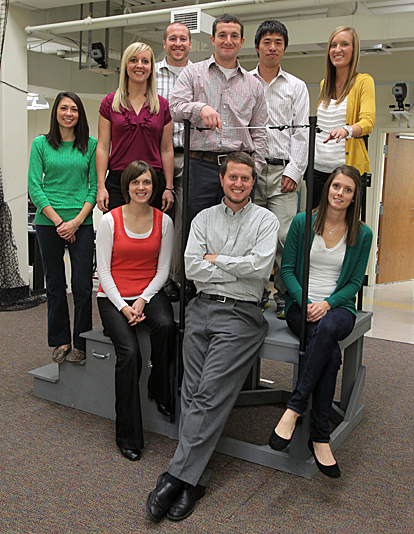Oh, your aching back? Your throbbing knee? You’re not suffering alone. Musculoskeletal disorders affect more than one in four Americans, with annual direct and indirect costs for bone and joint health totaling $849 billion; that’s 7.7 percent of the U.S. gross domestic product.

Dr. Brian Pietrosimone and doctoral students worked it for the camera, top row, from left, Michelle McLeod, Brittney Luc, Adam Lepley, Pietrosimone, Masafumi Terada and Amanda Murray, and bottom row, from left, Hayley Ericksen, Matthew Harkey and Megan Quinlevan.
Conditions that include osteoarthritis, muscle strains and lower back pain affect more people than do cancer, respiratory distress, cardiovascular disease or obesity, he said. “But that’s not well-publicized, maybe because everyone has aches and pains, and no one dies from them.”
Or do they? He noted, “Such disorders are often a gateway to these other conditions. If you have an injury to your knee or ankle, you don’t walk or move well. That can cause changes in your lifestyle and help create obesity, which can lead to cardiovascular or respiratory disease.”
Understanding the origins of musculoskeletal disorders has been a priority for Pietrosimone since he joined UT four years ago. Last year, he teamed with department colleagues Drs. Phillip Gribble, Abbey Thomas and Charles Armstrong to combine three longstanding research sites to create the Musculoskeletal Health and Movement Science Laboratory.
It’s a space for many and varied avenues of research with a common goal: to improve movement for people of all ages suffering from lower-extremity joint injuries.
Because two areas in the body — the brain and the spinal cord — generate movement, they are the focus of the cutting-edge research technology utilized in the labs. A study of the brain’s pathways following injury to the anterior cruciate ligament (ACL) in the knee, for instance, showed something surprising happening when the knee could no longer move correctly.
“Everyone expects the loss of muscle strength following an ACL injury,” Pietrosimone said. “In fact, the pathways that generate the messages from the brain and spinal cord are changed.
“Right now, the current paradigm for joint injury rehabilitation is that you strengthen the supporting muscles. But we need to back up our interventions and target them to the brain and spinal cord.”
As well, he added, UT researchers are finding that muscle weakness may originate in the brain for some patients, in the spinal cord for others: “It’s very preliminary, but we’re thinking this will develop into an individualized approach to health care.”
How a person moves is studied as well, thanks to technologies that can track and animate trajectories of movement as individuals walk, and how much force they put out with every step taken — force that the body normally distributes via the muscles. However, with many joint conditions, including osteoarthritis, energy is absorbed directly by structures of the joint, hastening its degeneration.
“We use computers to show people in real-time what their bodies look like in motion and we can teach them how to move correctly via making real-time adjustments,” Pietrosimone explained. “They’re essentially training the cortical pathways connecting their brain and muscles.”
A collaboration with Dr. Michael Tevald in the college’s Physical Therapy Program uses transcutaneous electrical nerve stimulation to improve the function of thigh muscles — the heavy lifters — in arthritis patients. The tingling electrical stimulus reactivates the neural messages in muscles weakened by the disease, Pietrosimone said, “and gives [patients] more bang for the buck in rehab.”
Future plans include an increased presence in UT’s orthopedics program, the creation of larger patient databases to better predict outcomes, and further work with arthritis biomarkers to improve understanding of the disease that’s the end stage of any physical injury.
Crediting fellow faculty for the surge in research, he also singles out students, including eight doctoral students he rates as the best in the entire country. Some 20 master’s candidates work on thesis projects, an integral part of the department’s research, and undergraduate students play research roles as well.
“I tell them all that their work is part of a research push that we hope changes clinical practice someday,” he said.
“We try here to be very problem-oriented. We have a lot of what you might call neat technological toys here, but we’re not testing just to test things. We want to improve life for actual people. To do that, we’ve often had to develop new skills, or collaborate with others who have those skills, evolving as we learn. Three years ago I would never have predicted I’d be involved in biomarkers.”
Unconsciously invoking metaphors of motion, he added, “You chase the problem and see where it takes you. Research is not linear; it has to react and pivot easily.”